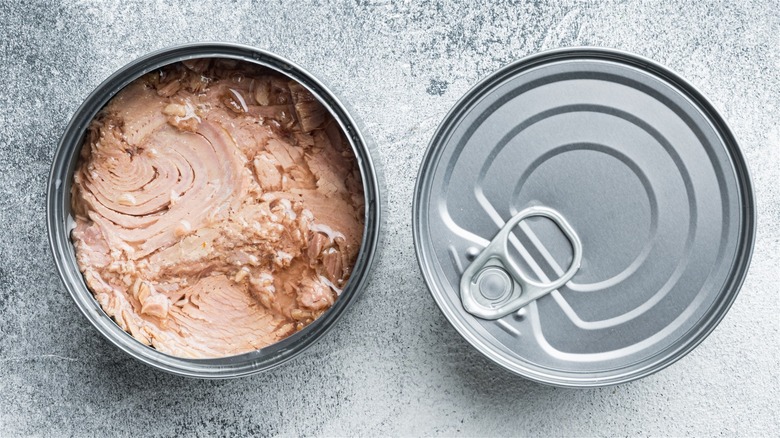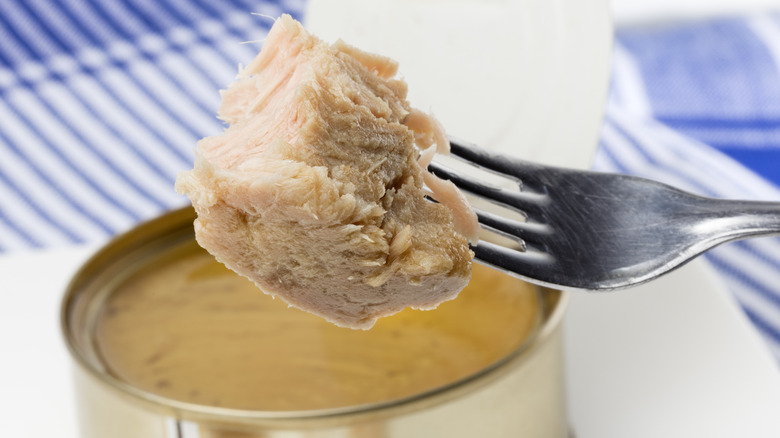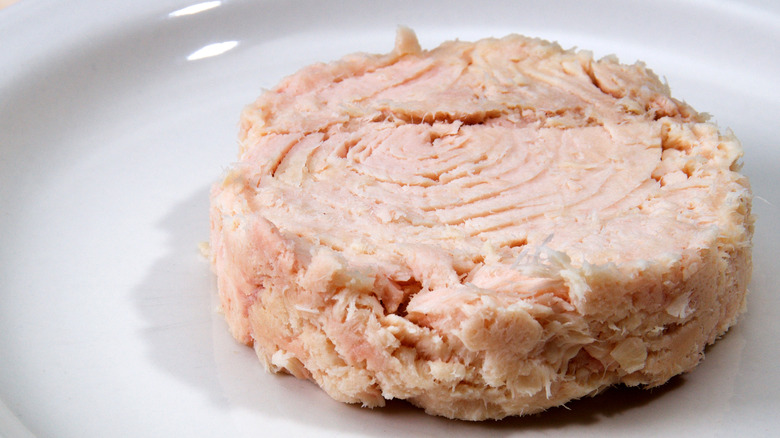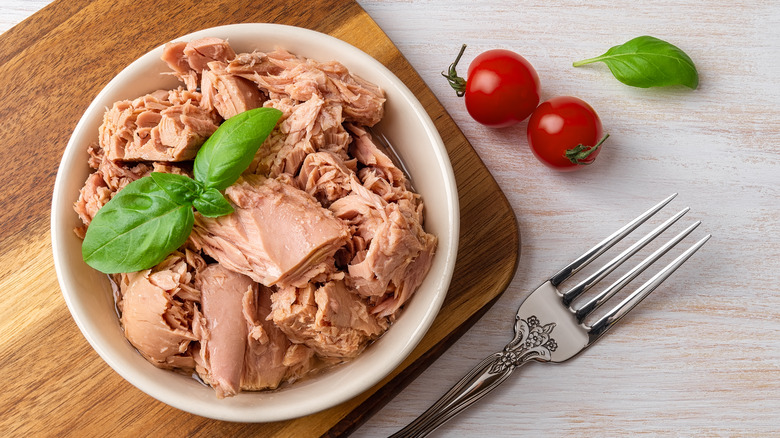The Type Of Canned Tuna You May Want To Skip At The Grocery Store
From tuna casserole to tuna salad sandwiches, there are a lot of classic comfort-food dishes that rely on canned tuna. Fish in general is considered to be a healthy food; the FDA recommends that non-pregnant adults eat "at least" 8 ounces of seafood a week while those who are pregnant or breastfeeding should consume 8-12 ounces. Grocery store canned tuna is one of the easiest types of fish to prepare since it's already cooked. But there are some canned tuna options that are healthier than others, and it mostly comes down to mercury content.
The FDA says that pregnant and breastfeeding people should eat 2-3 "Best Choices" fish per week, or just one serving of "Good Choices" fish. Of the canned tuna options out there, light canned tuna has the lowest mercury content. It's considered a "best choice" fish by the FDA. Then, there's canned yellowfin tuna and canned albacore (white tuna), which are "Good Choices." As for children, the FDA simply recommends eating 2 servings a week from the "Best Choices" list and doesn't list guidelines for how many servings of "Good Choices" fish is safe. Bigeye tuna is best avoided by both sensitive populations because it has among the highest levels of mercury. If your family eats tuna frequently, and you have kids or are pregnant or breastfeeding, it might be best to leave the canned albacore and yellowfin on the shelf and instead opt for canned light tuna most of the time.
Mercury levels in tuna
Why does the mercury content between different types of canned tuna vary? It depends on the size and lifespan of different tuna species, as well as how mercury generally tends to accumulate in living things. While mercury is a naturally occurring element, pollution can also increase mercury in bodies of water. Plants and animals at the bottom of the food chain absorb that mercury and are eaten by small fish, which are eaten by medium fish, which are then eaten by large fish. But the mercury never goes away — in each of these instances, it simply accumulates in the body of the consumer. That's even true of us humans when we eat fish with a high mercury content.
That means that the larger a fish is, the more mercury it likely contains since it's spent its life consuming a large quantity of smaller, mercury-filled fish. (This also means older fish tend to have higher mercury levels.) Because bigeye tuna is large and has a long lifespan, it contains more mercury than other tuna species, making it one of the FDA's "Choices to Avoid." Thankfully, most varieties of canned tuna are safe to eat for many people. But pregnant or breastfeeding people and children, who need to be more careful about how much mercury they ingest, are safest sticking to canned light tuna, which has the lowest mercury content of the different canned tuna options. The good news? It's usually the most affordable, too.
Why children shouldn't eat too much tuna
Mercury can be particularly toxic to children, and some kinds of tuna have higher levels of mercury than others. In some areas where local populations rely on subsistence fishing for most of their diet, instances of cognitive impairment due to the consumption of mercury-containing fish were as high as 17 out of 1,000 children (via World Health Organization). Even smaller fish and shellfish living in waters polluted with mercury from industrial waste carry a high risk.
Because children are still developing, exposure to a toxic metal like mercury can have adverse effects and cause impairments to the central nervous system. Symptoms can include tremors, memory loss, neuromuscular effects, and more. Children's small stature also means that smaller quantities of mercury have a bigger impact on kids than they would on adults. Eating seafood is the number one way children are exposed to organic mercury. That's why the FDA is so careful to recommend just two servings weekly of seafood from the "Best Choices" list for children under 11, which includes canned light tuna (including skipjack tuna) and excludes albacore, yellowfin, and bigeye tuna.
Why pregnant and breastfeeding people should avoid too much tuna
For all the danger that mercury exposure poses to children, it's even more toxic to fetuses, newborns, and infants. That means that anyone who is pregnant or breastfeeding should be careful about how much tuna they eat, especially if they're not always opting for canned light tuna. Not only does organic mercury ingested by a pregnant person find its way into the system of the fetus, but it can also be transferred via breast milk.
In the womb, organic mercury (like that in tuna) consumed by the pregnant person can pass through the placenta and into the fetus, which hasn't yet developed a way to excrete it. Prenatal mercury exposure has been linked to lower IQs, lower test scores, neurocognitive deficits, and neuromotor disabilities. That's why pregnant and breastfeeding people are instructed by the FDA to eat only two to three servings of fish from the "Best Choices" list weekly or just one serving from the "Good Choices" list. Pregnant or breastfeeding people who eat tuna frequently should stick to canned light tuna since they're only allowed one serving of canned albacore or yellowfin.



